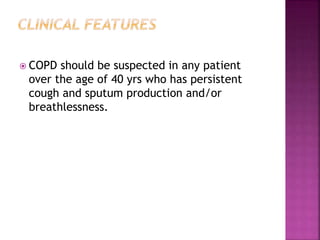This document provides information about COPD (chronic obstructive pulmonary disease). It defines COPD as a condition characterized by airway obstruction that does not change over several months and is not fully reversible. It notes that COPD is caused by both genetic and environmental factors, especially cigarette smoking. The document discusses symptoms, signs, diagnostic tests, and management strategies for COPD including smoking cessation, bronchodilators, inhaled corticosteroids, oxygen therapy, and management of exacerbations.




















